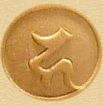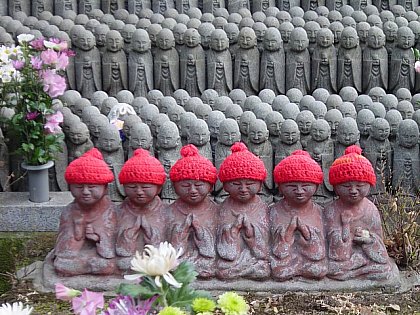|
|
|
|
 THIS IS A SIDE PAGE THIS IS A SIDE PAGE
RETURN TO MAIN JIZO PAGE
Japanese readings are given herein.
Benefits of Venerating
Kṣitigarbha Bodhisattva
Chn. = Dìzàng Púsà | Jp. = Jizō Bosatsu
As listed in the “Sūtra of the
Fundamental Vows of Jizō Bosatsu”
Sutra Name: 地藏菩薩本願経 or 地藏本願経
Reference: Taishō, XIII, p. 777-790
Jp. = Jizō Bosatsu Hongan Kyō
Jp. = Jizō Hongan Kyō (short name)
Chn. = Dizang pusa benyuan jing
Chn. = Dizang benyuan jing (short name)
- Ten Benefits, Chapter 11
- Seven Benefits, Chapter 13
- Twenty-Eight Benefits, Chapter 13
SUMMARY. This 7th-century Chinese translation from Sanskrit is perhaps the most widely known of all Jizō sūtras and texts. This 13-chapter sūtra contains the vows made by Jizō to save all sentient beings and stories about Jizō's prior lives before attaining enlightenment. Chapters 11 and 13 of this text mention the benefits that accrue to those who worship Jizō Bodhisattva. These benefits are translated below into English. There are numerous English names for this sūtra, including Sūtra of the Past Vows of Ksitigarbha Bodhisattva, Sūtra of the Past Vows of the Earth Store Bodhisattva, Sūtra of the Earth Store Bodhisattva, Ksitigarbha Bodhisattva Sūtra, Sūtra of Ksitigarbha Bodhisattva's Fundamental Vows, and less commonly the Earth Womb Sūtra. The Sanskrit text was translated into Chinese by Śiksānanda 實叉難陀 in the late 7th century, and in the following centuries entered Japan, where it was copiously copied and studied. The term Bodhisattva is rendered as BOSATSU in Japanese.

|
 Ten Benefits of Venerating Jizō Ten Benefits of Venerating Jizō
SUTRA NAME: Jizō Bosatsu Sūtra (Jp. = 地蔵菩薩本願経)
Chapter 11: Land Deities Who Protect the Dharma (Jp. = 地神護法品)
* Below translation Mark Schumacher, culled from various others.
* Also see English translation by Upasaka Tao-tsi Shih.
* Also see English translation by Pitt Chin Hui.
SUMMARY. Prthivi (Prithvi), the Hindu earth deva, known as Jijin 地神, Jiten 地天, or Kenrō 堅牢 in Japan, addresses the Buddha (Shakyamuni), extolling the virtues of Jizō Bodhisattva. (Editor’s Note: Indeed, Jizō was most likely derived from Prthivi, a Hindu goddess who personified the earth and was associated with fertility; details here.) Prthivi describes Jizō as the most beneficial savior of all sentient beings. Prthivi says Jizō devotees will gain ten benefits if they build places of worship to Jizō, and therein place images of Jizō, and thereafter burn incense and venerate Jizō with prayers and offerings. Importantly, Prthivi vows to use all her miraculous powers to protect Jizō devotees. In reply, the Buddha affirms Prthivi's vows and says all who show obeisance to Jizō will henceforth also enjoy the miraculous powers and support of Prthivi as well. Those who follow the sūtra’s instructions will enjoy the following benefits:
- Their lands shall be fertile
- Their households shall enjoy harmony forever
- Their deceased ancestors shall be reborn in the heavens
- Their (and their relatives) life spans shall be ever longer
- Their prayers and aspirations shall all be answered
- They shall never be harmed by calamities of flood and fire
- They shall never again experience fruitless beginnings
- Their bad dreams shall cease
- Their comings & goings shall be protected by guardian deities
- Their paths will always intersect with holy conditions
|

|
 Seven Benefits of Venerating Jizō Seven Benefits of Venerating Jizō
SUTRA NAME: Jizō Bosatsu Sūtra (Jp. = 地蔵菩薩本願経)
Chapter 13: Instructions to Humans & Devas (Jp. = 嘱累人天品)
* Below translation Mark Schumacher, culled from various others.
* Also see English translation by Upasaka Tao-tsi Shih.
* Also see English translation by Pitt Chin Hui.
SUMMARY. The Buddha (Shakyamuni) says that devas, nagas, deities, humans, or demons who hear Jizo's name and thereafter worship, praise or show obeisance to images or sūtras of Jizō will gain the following seven benefits.
- They shall rapidly climb the divine stages of advancement
- They shall be free of all bad karma
- They shall be guarded by all the Buddhas
- They shall never again suffer setbacks along the Bodhi path
- They shall experience greater willpower to do good
- They shall remember their past lives and experiences
- They shall eventually achieve Buddhahood
|

|
 28 Benefits of Venerating Jizō 28 Benefits of Venerating Jizō
SUTRA NAME: Jizō Bosatsu Sūtra (Jp. = 地蔵菩薩本願経)
Chapter 13: Instructions to Humans & Devas (Jp. = 嘱累人天品)
This chapter is commonly known in Japan as the “Jizō Bosatsu Hongan Kudoku Kyō” 地蔵菩薩本願功徳経.
* Below translation Mark Schumacher, culled from various others.
* Also see English translation by Upasaka Tao-tsi Shih.
* Also see English translation by Pitt Chin Hui.
SUMMARY. Translation begins here: If pious men and women hoping for better karma in future lives look upon any type of image of Jizō Bodhisattva, and hear this sūtra, and read or recite this sūtra while offering incense, or flowers, or food and drink, or clothing, or any other precious thing, and behold and venerate with respect, then these people will be blessed with the following twenty-eight benefits:
|
#
|
Benefits
Listed
in Sutra
|
Benefits
in Modern
Vernacular
|
Benefits
in English
Modern vernacular with notes
|
|
1
|
天龍護念
|
天龍が
守ってくれる
|
The Tenryū (protective deities) will guard and defend thee. Note 1
|
|
2
|
善果日増
|
善果が
日ごと増す
|
The fruits of goodness & virture will shine increasingly on thee.
|
|
3
|
集聖上因
|
勝れた因が集る
|
The wisdom of the sages shall accumulate within thee.
|
|
4
|
菩提不退
|
菩提が
退ことがない
|
No retreat along the Bodhi path will be suffered by thee.
|
|
5
|
衣食豊足
|
衣・食に豊で
不足しない
|
Food, drink, and clothing will not be lacking thee.
|
|
6
|
疾疫不臨
|
病気に
かからない
|
Disease and illness will not harm thee.
|
|
7
|
離水火災
|
水の難、火の
難に遭わない
|
Calamities of fire and water will not hurt thee.
|
|
8
|
無盗賊厄
|
盗賊の被害に
遭わない
|
Thieves and robbers will not trouble thee.
|
|
9
|
人見欽敬
|
人から敬われる
|
Respect from others will come upon thee.
|
|
10
|
神鬼助持
|
鬼神が助けとなる
|
Demonic spirits shall (even) aid thee.
|
|
11
|
女転男身
|
女が男性に転ずる
|
From female to male transformed will become thee. Note 2
|
|
12
|
為王臣女
|
王の女性大臣となる
|
Female minister to kings shall become thee.Note 3
|
|
13
|
端正相好
|
容姿端麗で相がよい
|
Comely in appearance shall be thee.
|
|
14
|
多生天上
|
何度も天界へ
生まれ変わる
|
Constant rebirth in deva heaven shall be accorded thee. Note 4
|
|
15
|
或為帝王
|
或いは帝王になる
|
The role of monarch may fall unto thee.
|
|
16
|
宿智命通
|
前世に得た智慧に
よって将来を知る
事ができる
|
Wisdom from previous lives shall illuminate the future for thee.
|
|
17
|
有求皆従
|
求める者は皆、従う
|
All those who beseech thee shall follow thee.
|
|
18
|
眷属歓楽
|
眷属が歓び楽しむ
|
A joyous and content family shall be granted thee.
|
|
19
|
諸横消滅
|
全ての不道理を
消滅させる
|
Chance, falsehood, and untrue doctrines shall cease to thwart thee.
|
|
20
|
業道永除
|
苦楽の報いの
善悪の業を永久
に取り除く
|
Eternal freedom from the karmic chain shall be thine.
|
|
21
|
者去処盡通
|
苦しみに通じる
ところが滅びる
|
No obstacles along any path shall obstruct thee.
|
|
22
|
者夜夢安楽
|
夜の夢見が
安らかになる
|
Peaceful and untroubled dreams will slumber bring thee.
|
|
23
|
者先亡離苦
|
先祖が苦しみ
から離れられる
|
Thy ancestors who suffer from evil karma shall be liberated.
|
|
24
|
者宿福受生
|
前世の福を
受け、生まれる
|
Reborn shall they be based on the good karma of thy past life.
|
|
25
|
者諸聖讃歎
|
全ての聖者が
ほめたたえる
|
Praised by the sages shall become thee.
|
|
26
|
者聰明利根
|
素質や能力が
すぐれる
|
Intelligent and wise in nature shall become thee.
|
|
27
|
者饒慈愍心
|
哀れみ、慈しむ
心を与える
|
Rich in kindness and compassion shall become thee.
|
|
28
|
者畢竟成仏
|
絶対的な悟りを
得ることができる
|
Enlightened shall become thee.
|
|
Vow of Ksitigarbha Bodhisattva
From the Sūtra of the Fundamental Vows of Jizō Bosatsu
Jp. = Jizō 地蔵, Ch. = Ti-tsang or Dizang, Skt. = Kshitigarbha
"Even if the good deeds of beings are as little as a hair, a drop of water, a grain of sand, a mote of dust, or a bit of down, I shall gradually help living beings to liberation. World Honoured One (Buddha), do not feel distressed over beings in generations to come. Only after the hells are empty will I become a Buddha."
|
|
|

Translator’s Notes
If you find errors or omissions, please contact the translator.
-
Jizo Bosatsu
地蔵菩薩
by Kaikei
Painted Wood
H 90.6 cm
Early 13th Century
Todaiji (Tōdaiji) Temple
東大寺, Nara
Photo courtesy
日本の仏像100選
ISBN4-391-12629-X
|
Vow 1. Tenryū. Tenryū is generally translated as gods and dragons, with the Japanese term TEN equal to the Sanskrit term DEVA, and the Japanese word RYŪ equal to the Sanskrit word NAGA. Both concepts are of Hindu origin, with Deva referring to “celestial beings” and Naga referring to “serpentine creatures,” including dragons. More specifically, however, the term Tenryū 天竜 refers to the Tenryū Hachibushū 天竜八部衆. These are eight classes (legions) of Hindu deities who converted to Buddhism after listening to a sermon by Shaka (Historical Buddha), and thereafter became protectors of the Dharma (Buddhist Law). See Hachibushu (Eight Legions) for details. It may also refer to the Eight Great Dragon Kings 八大竜王 (Jp. = Hachidai Ryū-ō) who are mentioned in the Lotus Sutra, which says the eight, each with many followers, assembled on Eagle Peak to hear the sutra as taught by Shaka (the Historical Buddha).
- Vow 11, From Female to Male. In orthodox Buddhism, only males could reach Buddhahood -- females could not unless they were first reborn into manhood (a higher state in the cycle of transmigration). In Japan, this transformation is known as Henjō Nanshi (変成男子), or “changing into a man.” This teaching lost much of its bite with the widespread popularity of the Lotus Sutra (法華経) among women of the Japanese court during the Heian period (9th-12th centuries). In the 12th chapter (Devadatta) of the Lotus Sutra, the daughter of the Dragon King Sagara attains enlightenment at the young age of eight, illustrating the universal possibility of Buddhahood for both men and women. Japanese ladies of the Heian court thus turned to the worship of the Lotus Sutra to ensure their salvation. Extant statuary offers even more compelling evidence of changing attitudes. In early Japanese Buddhism, the concept of venerating a female statue would have been unthinkable. But by the 11th century, in both China and Japan, statues of Kannon Bodhisattva clearly portray the male deity as female. Indeed, a persistent femininity clings to Kannon imagery in both pre-modern and modern Japan. Today, Kannon is known as the "Goddess of Mercy" in Japan and the West. Note: Among Buddhist art historians, gender is not typically an issue. Statues are primarily portrayed as asexual or genderless. The artisans of Japan’s classical Buddhist statuary carved the faces, bodies, and robes (drapery) in ways that transcended male and female forms, in ways that avoided stressing a male persona. Nonetheless, the orthodox view (much weakened) is that all Buddha and Bodhisattva are male. One indication -- many Buddhist statues in Japan have mustaches.
- Vow 12. Female Minister to Kings. This is very puzzling, for in the prior Vow 11, the pious believer has assumed male form. Nonetheless, in Japan, women have held high roles in government, with some half-dozen serving as empresses. One example is Empress Suiko 推古, who reigned from + 592 to 628 and became one of Japan’s first Buddhist monarchs. After ascending the throne, however, she gave the reigns of power to her nephew and son-in-law, Prince Shōtoku, one of the loftiest patrons of Buddhism in Japan’s long history. Additionally, Jizo Bosatsu was sometimes reborn as a female in prior lives.
- Vow 14. Rebirth into Deva Heaven. The Deva realm is the highest of the six states of transmigration. See Cycle of Suffering (Skt. = samsara) for details. The six states (high to low) are:
1. Deva; realm of heavenly beings with godlike powers
2. Human; realm of desire and passion, and good and evil
3. Ashura; realm of anger, jealousy, and constant war
4. Animals; realm of stupidity and servitude
5. Hungry Ghosts; realm of great craving and eternal starvation
6. Beings in Hell; worst realm, wracked by torture and aggression
- Why the Number 28? This is not easily explained, nor is the answer definitive. The number 28 represents many different important concepts in both ancient cosmology and early Buddhism. In Chinese astrology, for example, there were four celestial “palaces” in the sky (representing the four cardinal directions), each corresponding to seven stations (or lodges) of the moon’s path overhead. This yielded a total of twenty-eight combinations. This scheme was apparently incorporated in early Buddhism, for Buddhism has 28 Heavens (Skt. = Devalokas), which include six of the desire world, eighteen of the form world, and four of the formless heavens. The list goes on and on. There are the 28 Patriarchs of Mahayana Buddhism, the 28 Yaksas (protective spirits), the 28 Legions protecting Kannon Bodhisattva, etc. It is thus very likely that the “28 Benefits” of venerating Jizō stem from the same influence.

Om Pra Ma Ni Da Ni So Ha
Jizo’s Tibetan Mantra for Eradicating Fixed Karma.
Another version: Om Bla Ma-ni-Da-Rei So Ha
Rough Translation: Om. Blame is greatly dispersed. So be it!
Another Jizo Mantra.
On Kakaka Bisanmaei Sowaka
おん かかか びさんまえい そわか
Japanese Mantra for liberating beings from the hell realms.
Sanskrit Version: Om ha-ha-ha vismaye svaha
Learn more at E-Sangha (your must register first)
 
KA (Japanse Pronunciation)
Sanskrit Seed Syllable for Jizo Bodhisattva

Roku Jizo 六地蔵 (Six Jizo) at Hase Dera in Kamakura, Japan
Jizo Bosatsu, Kamakura Era
Located at Tsurugaoka
Hachimangu Museum
in Kamakura City |
|
Six States of Existence
Jizo vowed to assist beings in each of the Six Realms of Existence (the karmic wheel of rebirth). Within the six realms, the lowest three are called the three evil paths. They are the states of:
(1) people in hell
(2) hungry ghosts
(3) animals
Above these three realms are:
(4) Asuras
(5) Humans
(6) Devas
For details on the six realms (also called the Six Paths of Transmigration or Reincarnation, the Wheel of Life, or the Cycle of Suffering), click here.
Roku Jizo (Groupings of Six Jizo)
In Japan, groupings of six Jizo statues (one for each of the Six Realms) are quite common and often placed at busy intersections or oft-used roads to protect travelers and those in "transitional" states. Jizo also often carries a staff with six rings, which he shakes to awaken us from our delusions. The six rings likewise symbolize the six states of rebirth and Jizo’s promise to assist all beings in those realms. In Chinese traditions, Jizo shakes the six rings to open the doors between the various realms.
|
|

JIZO SUTRAS & TEXTS

THIS IS A SIDE PAGE
RETURN TO MAIN JIZO PAGE
|
|